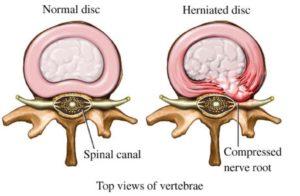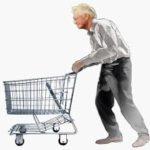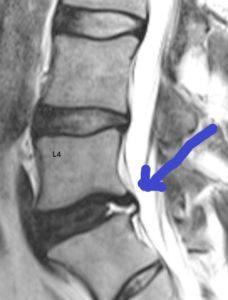Introduction: Lower Back Pain When Sitting
After a long day on your feet sitting down is supposed to be way to relaxing. Unfortunately for some sitting for any length of time can be painful. Most people experience low back pain at some point in their life. The lifetime prevalence of low back pain is 85% (1). Let’s take a deeper look at the different types of pain and causes of low back pain when sitting.
Where in Your Back Does It Hurt?
The location of low back pain can vary signficantly from patient to patient. It is important to localize the pain. Common areas of low back pain include:
Upper Low Back Pain
This pain is in the upper portion of the back at the junction between the thoracic and lumbar spine.
Low Back Pain
This pain is localized in the low back below the level of the hips.
Midline Low Back Pain
This pain is localized right in the center of the low back.
Unilateral Low Back Pain
Low back pain can be localized exclusively on the right or left side of the back.
Buttock Pain
Some patients that complain of low back pain actually have buttock pain. It can be on either the right or left side or both. It can be superficial or deep.
Iliac Crest Pain
The Iliac Crest is top portion of the Ilium bone. It can also be referred to as the waist bone. You know, when you are scolding someone and put your hand on your waist, that is your iliac crest. The gluteal muscles attach to this bone and when inflammed or injured they can be a significant source of low back pain.
Tailbone Pain
The Sacrum bone is immediately below the Lumbar spine. The Coccyx is immediately below the Sacrum. Both the Sacrum and Coccyx can cause significant low back, and dysfunction.
Types of Lower Back Pain Only When Sitting
Pain can present in many different ways. It can be intermitent or constant. The quality of the low back pain can also vary depending upon the actual source of injury. Common examples include:
Sharp and Stabbing
Dull and Aching
Throbbing/ Pulsating
Pins and Needles
Burning
Electrical
Common Causes of Lower Back Pain When Sitting
Disc Protrusion or Herniation

The Lumbar spine is composed for 5 boney building blocks that are called Vertebral Bodies. Sandwiched between each of the Vertebral Bodies is a Disc. The Disc is an important shock absorber that is composed of a thick outer layer and a gelatinous inner core. The Disc is susceptible to injury and degeneration. Common disc injuries include Disc Protrusions, Disc Herniations and Disc Extrusions.
The outer layer of the Disc known as the Annulus is rich is nerve fibers. Why does this matter? An increase in Disc pressure can stimulate these nerve fibers resulting in signficant pain and dysfunction. Lying down reduces the pressure on the Disc. Conversely sitting increases the pressure on the disc. Lower back pain when sitting can be due to Disc protrusions or Herniations.
Facet Injury

The Facet joint is a paired joint on the backside of the spine. They guide and limit motion of the bones in the low back (2). Like your knee and hip joints, the Facet joints are lined with cartilage which allows the joints to move smoothly. Facet joints are susceptible to injury and degeneration. Facet joint injuries can be caused by trauma, heavy lifting, repetitive movements and car accidents. Lumbar Facet joints are a common source of pain accounting for between 15-45% of low back pain (3).
Ligament Instability
Ligaments are thick pieces of connective tissue that connect bone to bone. They provide important stability for the low back. Important ligaments in the low back include the Supra and Interspinous Ligaments. Ligament laxity due to injury or cogential laxity can cause low back pain when sitting.
Nerve Compression
Nerves exit at each level in the low back. They exit through a boney doorway which is called the Neural Foramen. The doorway may be narrowed by Disc Protrusions, Disc Herniation, Facet overgrowth, Bone Spurs or Ligamental Thickening. This can cause significant irritation and or compression of the exiting nerve resulting in low back pain and Sciatica. Sitting increased the pressure on the Disc which in turn may increase the nerve compression. Often times the result is an increase in low back pain when sitting.
Spinal Stenosis

Stenosis refers to a narrowing. In the Lumbar spine there are two principal types of Stenosis: Central Canal Stenosis and Foraminal stenosis.
Central Canal Stenosis occurs when there is narrowing of the central spinal column causing pressure on the spinal cord. Patients with moderate to advanced Central Canal Spinal Stenosis tend to walk in hunched forward posture. This is often times referred to as a ” shopping cart sign” as patients are bent forward in an attempt to open up the narrowed canal by flexing forward. Patients can also have severe leg pain with walking causing them to stop after several yards due to pain.
Foraminal Stenosis occurs when there is narrowing of the boney doorway through which the spinal nerves exit. This can occur on one side or both sides. Symptoms can include radiating leg pain, numbness, weakness and muscle shrinkage.
Sacroiliac Joint Dysfunction

The Sacroiliac Joint (SIJ is a major joint in the low back. It is composed of the Sacrum and the part of your pelvis called the Ilium. There is an right and left SI joint. Like your knees and hips, the SI joint is lined with cartilage. It is stabilized through an extensive network of ligaments. The SIJ can be injured through both traumatic and nontraumatic causes (4). Traumatic causes of SI joint injury include sudden and repetitive heaving lifting, rear end MVAs and hard falls onto the buttock. Non traumatic causes include Lumbar Fusion, pregnancy due to elevated hormone levels and Scoliosis. SI joint injury and instability is a common cause of unilateral low back pain when sitting.
Annular Tear 

The Disc is composed of two principal parts: the Annulus Fibrous and the Nucleus Pulposus. The Nucleus is the gelatinous core that functions as a shock absorber. The Annulus Fibrous are outer fibers that surround and support the gelatious core. The Annulus is a strong radial tire-like structure that provides important stability for the Disc. The Annulus is susceptible in degeneration and injuries. A tear in the Annulus can occur with or without a Disc Protrusion or Herniation (5). The diagnosis of Annular tear is confirmed by MRI. On T2 imaging it is a bright small signal that looks a bright star in the evening sky. Annular tears are a common cause of low back pain when sitting.
Multifidus Muscle Atrophy
The stability of the Lumbar spine is dependent upon ligaments and muscles. The Multifidus is a small muscle that your doctor never talked to you. It is a critical to the stability of the Lumbar spine. Injury and weakness in the Multifidus can cause low back pain when sitting. To learn more please click on the video below.
Muscle Tightness
There a large number of muscles in the low back. They provide stability and allow us to rotate, bend forwards and backwards. They also have a protective role in that if there is an injury to the Lumbar Disc, Facet or tendon the muscles tighten. Persistent muscle tightness that does not respond to conservative treatment is a warning signal that you may have a low back injury. It warrants a deeper evaluation.
Spondylolisthesis
Spondylolisthesis is where one of the bones in the spine slips out of alignment. It can slip forward or backwards in relation to the other bones. This can cause injury to the Lumbar Discs, nerves and exiting nerves. Patients with Spondylolisthesis are unstable and can have lower back pain when sitting, bending or lifting.
Other Medical Conditions that Can Cause Lower Back Pain
Not all low back pain is due to injury of structures in the low back. Other important causes of low back pain include:
Kidney Stones
A Kidney Stone is a hard mass made from the chemicals in the urine. There are four types of Kidney Stones: Calcium Oxalate, Uric Acid, Struvite and Cystine. They can be small or large. They can localized irritation or block the flow or urine. Symptoms include severe one sided low back pain. Other symptoms include blood in the urine, fever and chills.
Gallbladder Disease
The Gallbladder is a part of your digestive system. Its main function is to store bile which helps break down fats. Inflammation of the Gallbladder or hardened deposits of bile called gallstones can cause Gallbladder disease and dysfunction. Symptoms include abdomen pain, fever, chills and low back pain. m
How You Can Prevent Lower Back Pain When You Sit (Overview)
The best way to avoid low back pain when sitting is to be proactive. Common strategies include:
Keep Moving
Movement is the best way to ward off back pain. Regular physical activity can make the back stronger to reduce future episodes of pain. Exercises should focus on increasing strength and improving range of motion.
Get Up from your Chair
Avoid prolonged sitting. If you sit at a desk in the office or at home all day, get up every 30 minutes and walk around. Consider a standing desk.
Posture
Optimize posture with neutral spinal alignment. Slouching compromises neutral spinal aligment and puts the Lumbar Discs, facets, ligaments and muscles at risk for injury and dysfunction.
Regular Exercise
Exercise has tremendous benefits both psychological and physical. Muscle mass and strength declines with age. Specifically, muscle mass decreases 3-8% per decade after the age of 30 and increases after the age of 60. Muscle strength is important for mobility and low back stability. Remember the adage: “Use it or lose it”
Stretching
Stretching has many important health benefits. Stretching can improve flexibility, range of motion, and posture which in turn can improve low back health and vitality.
Home Treatments to Ease Lower Back Pain
Mild low back pain after a long day or athletic event is not uncommon. When possible, it is best to resume normal or near normal activity as soon as possible. Conservative home treatment options include:
- Intermittent Heat or Ice
- Stretching
- Gentle Massage
- Safe oral anti-inflammatory medications such as fish oil and Turmeric. NSAIDs such as Motrin or Aleve have significant side effects and should be avoided. To learn more please click here.
- Sleep with a pillow under your knees or on your side
When to Call Your Doctor
Pain tolerance can vary significantly from patient to patient. Low back pain that is tolerable for one patient may drive another one to the emergency room. You should consider seeing your doctor if you have:
- Low back pain is persistent and not responsive to conservative care
- Persistent leg numbness and tingling
- Fever and chills
- Loss of bowel or bladder function
How Important Is Getting A Solid Diagnosis?
Back pain is not a diagnosis. It is a symptom. For the very best clinical results it is critical that an accurate diagnosis is made. Specifically based upon medical history, physical examination and radiographic tests what structure or structures are causing your ongoing pain. This is the standard of care at the Centeno-Schultz Clinic.
Some pain clinics operate on the theory that a patient’s pain is arising from a single source. Many refer to this as identifying the “pain generator”. Accordingly, they will inject a specific part of the spine with diagnostic injections. For example, they may start with Lumbar Facet injections asking the question is the pain arising from the Facet Joints. If Facet Injections fail to provide benefit they move on and perform diagnostic Epidural injections. The problem with this model is that body is complex with many different, truly remarkable structures that all work in concert with one another.
At the Centeno-Schultz Clinic we understand the importance of viewing the body as a whole. We view the spine as a functional spinal unit (FSU). The Functional Spine Unit is composed of Discs, Facet Joints, bones, ligaments, tendons, and muscles. To learn more about what all these parts do, please click on the video as it will bring this whole topic together.
Treatment Options
At the Centeno-Schultz Clinic we bring a standard of care and expertise that is truly unique. We were the first clinic in the world to inject Bone Marrow Concentrate into the Lumbar Disc in 2005. Treatment of common orthopedic conditions with PRP and Bone Marrow Concentrate is our singular focus. We do not inject Botox, burn nerves using Radiofrequency, use high dose steroids or manage chronic narcotics. We are committed to highest standard of care which includes:
- Establishing the correct diagnosis
- Using ultrasound or x-ray guidance on all injections
- Treating the spine as a Functional Unit (FSU))
- Determining the most appropriate treatment option: Platelet Rich Plasma or Bone Marrow Concentrate or both.
- Determining the appropriate PRP dose given the injury and your age. To learn more please click here.
- Determining the type of Bone Marrow Concentrate: same day procedure or culture expanded ( Regenexx- SD or Regenexx-C)*
- Identifying the appropriate rehabilitation to ensure best clinical outcome.
The Centeno-Schultz Clinic are experts in the evaluation and treatment of low back pain when sitting. Our goal is to avoid patient’s reliance on potentially addicting narcotics or life altering surgeries. To learn more about the complications associated with low back fusions please click here.
In Summary
- Low back pain is common and most likley with affect you at some point in your life.
- The location of low back pain varies but is important to localize if possible.
- The quality of low back pain also varies. Common examples include sharp, stabbing, dull, aching and burning.
- Common causes of low back pain when sitting are disc protrusion, facet injury, ligament instability, nerve compression, spinal stenosis, annular tear and sacroiliac joint dysfunction.
- Other important causes of low back that need to considered are kidney stones and gallbladder disease.
- Strategies to prevention low back pain when sitting include limited sitting, improved posture, regular exercise and stretching.
- It is time to contact a doctor when your low back is persistent despite conservative care, persistent numbness and tingling, fever and chills or loss of bowel or bladder function.
- Low back pain is not a diagnosis but rather is a symptom. Getting an accurate diagnosis is critical if you want the very best clinical outcomes.
- At the Centeno-Schultz Clinic treatment options for low back pain when sitting may include x-ray or ultrasound guided injections of PRP or bone marrow concentrate.
If you or a loved one has low back pain when sitting that has not been responsive to conservative care, please schedule a telephone Candidacy discussion with a board-certified, fellowship-trained physician. From the comfort of your home or office, learn what treatment options are available for you. Call today and stop the pain, misery, and suffering.
*Regenexx-C is only avialble at a licensed site in the Cayman Islands.
1.Kiapour A, Joukar A, Elgafy H, Erbulut DU, Agarwal AK, Goel VK. Biomechanics of the Sacroiliac Joint: Anatomy, Function, Biomechanics, Sexual Dimorphism, and Causes of Pain. Int J Spine Surg. 2020 Feb 10;14(Suppl 1):3-13. doi: 10.14444/6077. PMID: 32123652; PMCID: PMC7041664.
2.Jaumard NV, Welch WC, Winkelstein BA. Spinal facet joint biomechanics and mechanotransduction in normal, injury and degenerative conditions. J Biomech Eng. 2011;133(7):071010. doi:10.1115/1.4004493
3.Perolat R, Kastler A, Nicot B, et al. Facet joint syndrome: from diagnosis to interventional management. Insights Imaging. 2018;9(5):773-789. doi:10.1007/s13244-018-0638-x
4.Chuang CW, Hung SK, Pan PT, Kao MC. Diagnosis and interventional pain management options for sacroiliac joint pain. Ci Ji Yi Xue Za Zhi. 2019 Sep 16;31(4):207-210. doi: 10.4103/tcmj.tcmj_54_19. PMID: 31867247; PMCID: PMC6905244.
5.Farshad-Amacker NA, Hughes AP, Aichmair A, Herzog RJ, Farshad M. Is an annular tear a predictor for accelerated disc degeneration? Eur Spine J. 2014 Sep;23(9):1825-9. doi: 10.1007/s00586-014-3260-8. Epub 2014 Mar 13. PMID: 24622958.
6.Volpi E, Nazemi R, Fujita S. Muscle tissue changes with aging. Curr Opin Clin Nutr Metab Care. 2004;7(4):405-410. doi:10.1097/01.mco.0000134362.76653.b2

